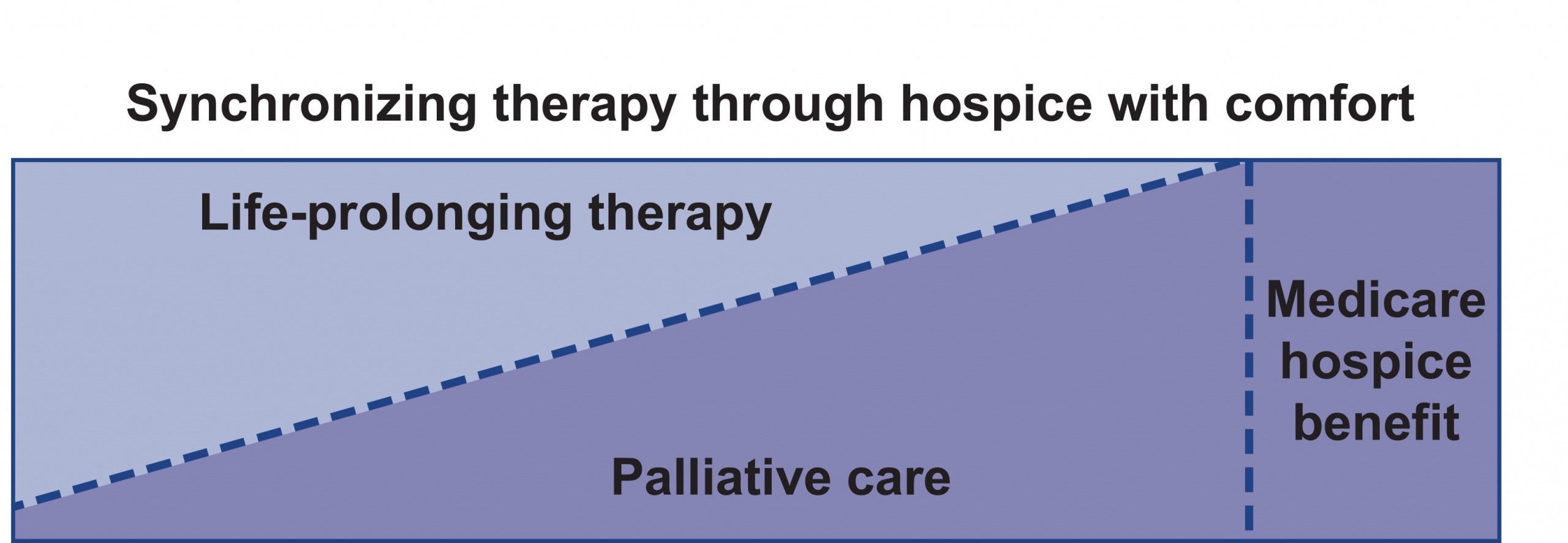Hospice
We cannot change the outcome, but we can affect the journey.
-Ann Richardson
Palliative Care vs. Hospice
Both palliative care and hospice care provide comfort. But palliative care can begin at diagnosis, and at the same time as treatment. Hospice care begins after treatment of the disease is stopped and when it is clear that the person is not going to survive the illness.
Hospice care is intended to provide support to those in the final phase of terminal illness. It focuses on the quality of life and comfort of the patient instead of treatment or cure. Hospice is also called end-of-life care as it’s main objective is to alleviate pain, allowing the patient to live the rest of his/her life as comfortable as possible.

Hospice is a difficult question. Many people feel that considering hospice means admitting defeat. It is important to know that you can choose to discontinue hospice at any time and that choosing hospice care does not mean “giving up.” Sometimes hospice is the best way to ease the pain and suffering of the one you love. It is important to know the difference between Hospice and Palliative care. Hospice is intended to allow the patient to enjoy the rest of his/her life as much as possible when the end is near.
An appropriate time to start considering hospice is when the patient has suffered significant declines with no signs of improvement. Generally speaking, a physician must diagnose terminal illness with less than 6 months to live in order to access hospice. If the patient outlives the six month timeline, a doctor’s exam and diagnosis is required in order to continue care.
Hospice care can be discontinued if the patient feels they are improving or want to pursue alternative courses of treatment, and can be resumed at a later time, pending the patient meets the criteria to request hospice service.
Hospice is a personal decision to be made by the patient and loved ones. Consider the following Signs of Decline to determine if hospice is appropriate for your situation.
Signs of Decline include, but are not limited to the following:
- Frequent hospital visits
- Physical/functional declines
- Walking
- Eating
- Dressing
- Incontinence
- Extreme weight loss
- Cognitive declines
- Communication
- Perception
- Skin integrity declines
- Multiple infections
- Pneumonia
- Urinary tract infections
- Bacterial infection
- Routine Home Care
- Continual Home Care
- Inpatient Level Care
- Respite Care
Routine Home Care
If the patient does not require continuous care or have out of control symptoms, the patient is typically placed on Routine Home Care. This type of care is given at home. This includes:
- Registered Nurse (RN) Case Manager Visits
- Social Worker (As Needed)
- Chaplain
- Home Health Aide Services
- Counselors
- Medications
- Equipment
- Communication with a Hospice Medical Director
- Therapy (If Needed)
RN visits and social worker visits are determined based on the needs of the patient. Home Health Aides may visit 1-3 times per week to help with activities of daily living. In addition, there is also access to a 24 hr. hospice RN who is “on-call” to answer any questions or deal with situations after hours when regular staff is not available. This hospice benefit is reimbursed by insurance.
Continuous Home Care
Continuous around-the-clock home care is provided if the patient symptoms are determined out of control. Hospice will provide staff (or in certain cases additional staff) to provide adequate care by trained hospice professionals.
An RN will evaluate the patient and consult with the attending physician and other necessary staff to determine a “plan of care.” If the RN determines the symptoms are out of control, around the clock hospice care will be provided, so long as the symptoms remain out of control.
Symptoms that may require continuous care include, but are not limited to:
- Severe Pain
- Unrelenting Nausea and Vomiting
- Severe Bowel Impaction/Intestinal Blockage
- Acute “Terminal Restlessness,” Psychosis, or Aggressiveness
- Bleeding
- Acute Respiratory Symptoms
Inpatient Level of Care
Symptoms that are out of control can be treated at a Hospice facility or Acute Care hospital. With Inpatient Level of Care, the patient receives more individualized attention with moment-to-moment assessments of the patient. The hospice staff coordinates with the attending physician to achieve patient comfort.
Respite Care
Sometimes, families that provide care for the patient need a reprieve from the duties that come with taking care of a loved one. Respite care is an option that allows the patient and their family to choose to enter a facility temporarily to give the family a break from providing care. This is a difficult time for everyone, and caregivers need to rest and recuperate to continue to give support and care for their loved one.
After deciding if Hospice is the right decision to make, the next step is to discuss with the attending physician or healthcare provider. They will determine eligibility for hospice. Generally speaking, your healthcare provider can give you recommendations to hospice care providers or several hospices you can meet with and discuss care. You can also ask trusted friends, family, or respected persons to give you recommendations for facilities.
If in the case the physician does not agree with hospice, you can also directly contact hospice care for a direct referral. There are organizations in every state to help answer questions about hospice services and options available to you.
You can request a visit by the hospice providers you’re considering at no-cost and no-obligation. The hospice will send a clinician to the patient to make a clinical assessment and to answer questions. Usually, staff at a hospital, physician’s office, assisted living facility or nursing home can help set up the appointment with a hospice representative.
Hospice care does not only include medical, psychological, and social work, but it includes spiritually sensitive services as well. Usually, this role is reserved for the patient’s religious leader, a local clergyman, or hospice chaplain. This service is to provide a sense of peace when one approaches the end of life. The patient may have feelings of fear or question their life and meaning. Spiritual care is to help the patient get through this difficult time and help provide comfort and relief beyond physical or psychological. Often times, terminal illness brings complex and powerful emotions that are hard to comprehend. Hospice service provides spiritual care as a basic tenant of care.
Questions to ask Hospice providers can include, but are not limited to:
- What is the typical response time if we need to reach someone at the hospice after normal business hours, or on weekends and holidays?
- How quickly will a plan of care be developed for the individual by the hospice?
- How quickly can we expect pain and/or symptoms to be managed?
- How quickly will the hospice respond if medications do not seem to be sufficiently addressing pain or symptoms?
- What does the hospice do when someone’s pain cannot be adequately managed at home?
- If there is a need for inpatient care, how will that be addressed by the hospice?
- Are there any services, medications or equipment that the hospice doesn’t provide?
- What kind of out of pocket expenses should the family anticipate?
- How often will a hospice team member visit and how long will most visits last?
- When the hospice orders medication, where can it be picked up, or is it delivered by the hospice?
- Do members of the team providing care have additional training and certifications for their hospice and palliative care skills?
- What is expected of the family caregiver?
- Will the hospice provide training to family caregivers?
- Can the hospice provide respite care to give family caregivers a break and how does the hospice arrange that?
- What help do your hospice volunteers provide and how can we request help from a volunteer?
- Does the hospice measure quality of care and does it have any quality data it can share?
- What kind of bereavement support is offered by the hospice?
- If we are unhappy with some aspect of care the hospice is providing, who can we contact at the hospice?


